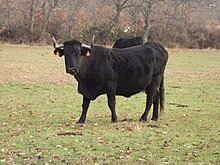Avileña-Negra ibérica
Avileña-Negra ibérica is a breed of cattle indigenous to Spain that originated in the Iberian Scheidegebirge . Sometimes the breed was also referred to as Serrana because of its mountain origin . The persistent and frugal cattle used to be used as draft animals, today they are kept extensively as beef cattle. Before the onset of winter, some of the animals are still driven or driven out of the mountains into the surrounding area as part of transhumance , where they overwinter on the Dehesas .
properties
The coat of cattle of the Avileña-Negra ibérica breed is uniformly black, with the exception of a variety called Bociblanca . The horns are black, slate-colored or white with black spots, the claws slate-colored or black. Adult cows weigh on average 500 to 600 kg, bulls from 800 to 1000 kg.
These cattle can also look for forage in difficult terrain, they achieve good meat growth, are fertile and, as suckler cows, are very caring. The animals are long-lived and very persistent.
Breeding and spreading
The breed originally comes from the area of the Iberian Scheidegebirge . Today Avileña-Negra ibérica is also kept in other regions of Spain, there are also around 5000 animals in Portugal.
The breed association Asociación Española de Criadores de Ganado Vacuno Selecto de Raza Avileña-Negra Ibérica was founded in 1971. The Ministry of Agriculture granted the association permission to keep a herd book in 1975 . This lists 35,800 (as of 2002) animals. There are around 130,000 specimens of this breed in total.
Keeping and use
In the past, cattle were used as draft animals, for example in front of ox carts to transport stones. Today the meat of the animals is valued for its good quality and marketed under the protected designations of origin Carne de Avila and Carne de la Sierra de Guadarrama .
In some mountain regions the cattle of the Avileña-Negra Ibérica breed graze on alpine meadows from June to November and on distant dehesas in Castile-La Mancha or Extremadura from December to June . The animals cover the 250 km long route on the traditional cattle drive routes, hiking about 25 km a day. The Cañada Real Leonesa Occidental , the Via de la Plata and the Cañada Real Soriana Occidental are mostly used for this . Today, for reasons of cost, transport by truck is increasing. While in the 1990s around 31,000 cattle traveled the distance on foot every year, there are still 18,000 today. In other regions of the mountains they practice alpine farming , the animals graze on alpine meadows in summer and in the valley in winter.
The cows are covered by the bull in the pasture, one bull is sufficient for 35 to 40 cows. The calves stay with the suckler cows until they are seven months old. Then the bull calves are castrated and fattened until they are ready for slaughter at the age of 12 to 14 months. The young cows can be mated for the first time at the age of 20 to 24 months, so they calve for the first time at 29 to 33 months. A cow has around 10 to 12 calves in the course of its life, the mean time between two births is 405 days.
proof
- ↑ a b c Asociación española de la raza Avileña-Negra ibérica , accessed on February 28, 2009
- ↑ Application for approval as a protected designation of origin "Carne de la sierra de Guadarrama" . 203 / C 206/05, accessed February 28, 2009
- ↑ Regulation (EC) No. 1483/2004 of the Commission of August 20, 2004

